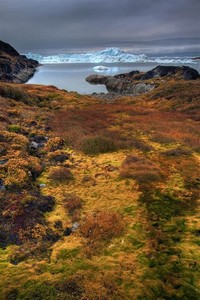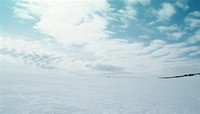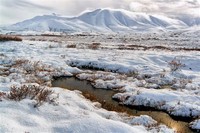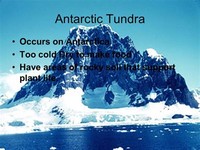Facts about Tundra

Due to the harsh climate of the Arctic tundra, regions of this kind have seen little human activity, even though they are sometimes rich in natural resources such as oil and uranium.

Arctic tundra occurs in the far Northern Hemisphere, north of the taiga belt (biome characterized by coniferous forests).

Scandinavian tundra tends to be a bit warmer, with winter temperatures averaging around 18 єF.

The ecological boundary region between the tundra and the forest is known as the tree-line or timberline.

The Arctic tundra is one of the world's youngest biomes, forming ten thousand years ago from a retreating continental glacier.

Alpine tundra also lacks trees, but does not usually have permafrost, and alpine soils are generally better drained than permafrost soils.

Alpine tundra transitions to sub-alpine forests below the tree-line; stunted forests occurring at the forest-tundra ecotone are known as Krummholz.

Tundra is a geographic area where the tree growth is hindered by low temperatures and short growing seasons, and the dominant vegetation is grasses, mosses, and lichens.

The Arctic tundra is home to several peoples who are mostly nomadic reindeer herders, such as the Nganasan and Nenets in the permafrost area (and the Sami people in Lapland).

Climate change threatens to reduce the percentage of tundra in Rocky Mountain National Park, as well as other areas, which will have an impact on both plant and animal life.

The term "tundra" comes from the language Kildin Sami t??ndra, the genitive of tundar, "treeless plain."

Notable animals in the Arctic tundra include caribou (reindeer), musk ox, snowshoe rabbit, snowy owl, lemmings, arctic fox, wolf, and polar bears (only the extreme north) (Blue Planet Biomes 2006).

The tundra also has a variety of colorful wildflowers that bloom for a short time, usually just a few months in summer.

Notable animals in the alpine tundra include Kea parrots, marmots, Mountain goats, sheep, elk, and pika.

The tundra is one of the Earth's major carbon dioxide sinks, taking in more carbon dioxide than released.

Another concern is that about one third of the world's soil-bound carbon is in taiga and tundra areas.

Antarctic tundra occurs on Antarctica and on several Antarctic and sub-Antarctic islands, including South Georgia and the South Sandwich Islands and the Kerguelen Islands.

One study has shown the potential for 77 percent or more of the tundra to be gone by the year 2100 (Oregon State University 2004).

Global warming is a potential threat to the Arctic tundra because of the permafrost.

Alpine tundra plants include grasses, hedges, herbs, and a few small shrubs.
Facts about the Tundra BiomeThe word tundra comes from a Finnish word tunturi, which means treeless plain or barren land.The tundra is a very fragile biome that is shrinking as the permafrost melts.Lemmings are small mammals that burrow under the snow to eat grasses and moss during the winter.More items...
What Makes the Tundra Biome Unique. The Tundra biome is the coldest of all five world biomes. A Tundra is a treeless area near the Arctic where the ground is always frozen and there's very little plant life. Tundras are found just below the ice caps of the Arctic, across North America, in Europe, Siberia and Asia.
Tundra soils are formed at high latitudes. It is usually very cold in the tundra. Tundra soils are generally frozen, and are classifed as Gelisols (think Gelato!). In order to be a Gelisol, permafrost needs to be within 100 cm of the soil surface.
Also, tundras and temperate grasslands both support grass but, tundras have short grass while temperate grasslands have thick grasses. Temperate grasslands and tropical rain forests can be found in South America and Australia. ... Tundra: Treeless biome with a layer of permafrost.Oct 29, 2014
Tundras are among Earth's coldest, harshest biomes. Tundra ecosystems are treeless regions found in the Arctic and on the tops of mountains, where the climate is cold and windy and rainfall is scant.
Average precipitation per season is 4.5 inches. The type of precipitation that falls in this climate is mostly snow in the winter, and in the summer it is rain, with occasional snow. The latitude range for the tundra is from the arctic circle to 60° to 70° latitude North.
LOCATION: The tundra biome is the coldest of all biomes. It is also quite big. The tundra covers about one fifth of the land on earth. The word tundra comes from a Finnish word that means treeless plain, which is a good description of the biome.
The tundra is located at the top of the world, near the North Pole. This enormous biome, extremely uniform in appearance, covers a fifth of the earth's surface. The most distinctive characteristic of tundra soil is its permafrost, a permanently frozen layer of ground.
Other Tundra Penguins. Two other penguin species can be found in tundra-like regions near Antarctica. ... Rockhopper penguins also live in tundra-like regions. However, they are found more frequently on southern Atlantic Ocean islands outside of the Antarctic polar front.Apr 25, 2017
There are three types of tundra: Arctic tundra, alpine tundra, and Antarctic tundra. In tundra, the vegetation is composed of dwarf shrubs, sedges and grasses, mosses, and lichens. Scattered trees grow in some tundra regions.
The Tundra Biome. Tundra is the coldest of all the biomes. Tundra comes from the Finnish word tunturia, meaning treeless plain. It is noted for its frost-molded landscapes, extremely low temperatures, little precipitation, poor nutrients, and short growing seasons.
The fauna in the arctic is also diverse:Herbivorous mammals: lemmings, voles, caribou, arctic hares and squirrels.Carnivorous mammals: arctic foxes, wolves, and polar bears.Migratory birds: ravens, snow buntings, falcons, loons, ravens, sandpipers, terns, snow birds, and various species of gulls.More items...
Although most biomes on Earth are covered in trees, the tundra is known for its lack of trees. ... Although there are few trees in the tundra, there is a variety of smaller vegetation that grows in this environment. Plants that are commonly found in the tundra biome include dwarf shrubs, grasses, mosses and lichens.
The tundra is located at the top of the world, near the North Pole. This enormous biome, extremely uniform in appearance, covers a fifth of the earth's surface. The most distinctive characteristic of tundra soil is its permafrost, a permanently frozen layer of ground.
Arctic tundra is located within the Arctic Circle around the ice cap at the frozen North Pole. Parts of several countries can be found within the Arctic Circle including Russia, Alaska, Sweden, Finland, Greenland and Canada.
The Arctic tundra, where the average temperature is 10 to 20 degrees Fahrenheit (-12 to -6 degrees Celsius), supports a variety of animal species, including Arctic foxes, polar bears, gray wolves, caribou, snow geese and musk-oxen. The summer growing season is just 50 to 60 days, when the sun shines 24 hours a day.
